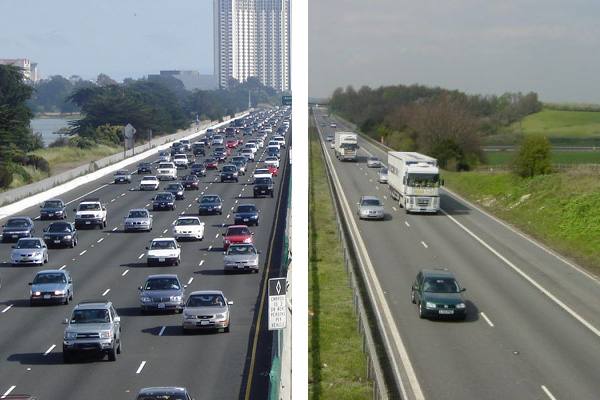
Travel can be revealing. In many cases, “where” can answer as much about a person as “who.” Much of who we are is tied up in what sorts of stores we frequent, where we work, and where we go for fun. While that sounds creepy—especially given the recent furor over smartphones storing location information—city-wide travel trends can help explain a lot about where we live.
A study comparing British and American travel habits discovered that trip distances in the United States predictably lengthen as the population thins out. In Great Britain, though, that relationship isn’t as strong, in part due to its greater population density. But when the researchers filtered out differences in income and density between Great Britain and the U.S., the British still traveled less.
The reason behind the travel discrepancy, the researchers suspect, lies in the strict separation of space for living, working, and shopping that is common in the U.S. To arrive at that conclusion, they had to use a bit of mathematical cleverness to make an apples-to-apples comparison. The model compared British and American cities of similar population and density, but shuffled the contents of the American ones until their general urban form resembled their ale-swilling counterparts. This meant that shops were now next to houses, grocery stores located just down the street, and pubs scattered about town. The results suggest that the jumbled urban land uses in England, Scotland, and Wales keep the lid on travel distances.
The British also get out from behind the wheel more often, using their feet for something other than operating gas and brake pedals. Whereas under 7 percent of trips in the U.S. are taken on foot, nearly one-third are in Great Britain. And while almost 90 percent of trips in the U.S. are made by car; only 58 percent are in Britain. More people in Britain take buses and trains, too. This modal flexibility could help explain why British of different incomes tend to take similar numbers of trips, unlike in the U.S. where wealthier people step out more often. In both countries, though, wealth is still tightly correlated with mobility, which is partially reflective of people’s ability to own, maintain, and fuel automobiles for such trips.
The one odd bit the researchers discovered was that people in smaller metropolitan areas—with populations between 250,000 to 500,000—traveled more frequently than larger ones. In theory, residents of large metro areas should have more available destinations and ways to get there, which left them stumped as to why big city people made fewer trips. My suspicion? Smaller metro areas may be a sweet spot in the spectrum, with just enough destinations and modes of transportation without the congestion present in big cities.
Source:
Giuliano, G., & Narayan, D. (2003). Another look at travel patterns and urban form: The US and Great Britain Urban Studies, 40 (11), 2295-2312 DOI: 10.1080/0042098032000123303
Photos by Minesweeper and Loganberry.
Related post:
Urbanites leave the car behind, but not as often as you might think